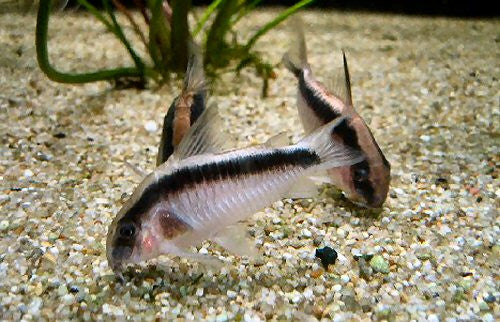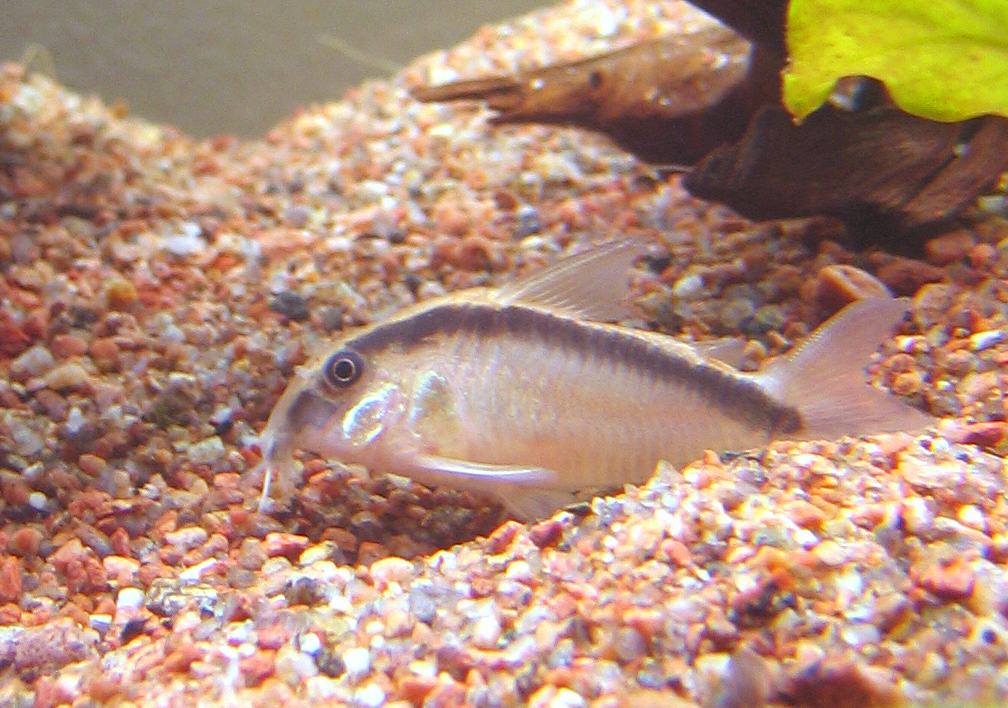Skunk Corydoras
Hailing from the Amazon Basin, the Skunk Corydoras, Corydoras arcuatus, has found its way into many an aquarium, making it a popular choice among aquarists.
This delightful schooling fish has certain care requirements that differentiate it from other Corydoras species.
- Experience Level: Beginner
- Hardiness: Hardy
- Minimum Tank Size: 10 gal (40 L)
- Maximum Size: 3 inches (7.6 cm)
- Temperament: Peaceful
- Temperature: 72 – 77° F (22 – 25° C)
- pH Range: 6.5 – 7.5
- Water Hardness: 2 – 15 dGH
- Diet: Omnivore
Table of Contents
Introduction
Size and Appearance
Care Guide
Tank Mates
Diet and Feeding
Breeding
Predominantly found in Peru, Brazil, Ecuador and Colombia within the Amazon River Basin, Skunk Corys are peaceful community fish that play an essential part in eliminating debris from the bottom of your tank. These creatures prefer to dwell at the bottom but occasionally rise to the water’s surface for a quick oxygen intake.
Their natural environment is characterized by a sandy substrate and is teeming with tree roots, forming a dense canopy. This natural shade aids in diffusing light while cooling the water temperature.
Size and Appearance
Skunk Corydoras, like all Corys, are scale-less armored catfish. Instead of scales, they have overlying bony plates and razor-edged fins for defense against predators. They have a comparatively stubbier nose than the Corydoras narcissus, and their transparent fins and tails are sprinkled with tiny dark spots.
The Skunk Cory displays a cream-colored body accented with a black stripe, originating from their mouth, passing through their eye and arching down to their tail. This distinct black stripe has earned them the nickname “arched Cory.” However, there are instances when the stripe fades to such an extent that it almost vanishes.
Males and females of this species are similar in appearance but can be distinguished by minute differences. Males tend to be slimmer and smaller with a more pointed and prominent dorsal fin. Conversely, females are larger, rounder, and exhibit more subdued colorations.
An average Skunk Cory grows up to three inches, and they can live up to 10 years. However, with optimal care, they have been known to reach up to 15 years.
Care Guide
- Minimum Tank Size: 10 gal (40 L)
- pH Range: 6.5 – 7.5
- Water Hardness: 2 – 15 dGH
- Temperature: 72 – 77° F (22 – 25° C)
- Lighting: Low to moderate, diffused lighting
- Substrate: Fine sand/gravel
- Brackish: No
- Water Flow: Weak/Low
- Tank Region: Mainly bottom
The level of care you provide your Skunk Cory fundamentally affects their lifespan and health. Understanding their habitat, feeding habits, and breeding behavior will equip you with the knowledge required for their care.
Begin by replicating their natural habitat. Fill their tank with a variety of plants, leaving ample swimming space. Create various hiding spots using plants, caves, and bogwoods. Skunk Corys have a sensitivity to salt and must be avoided in their tank. A minimum tank capacity of 10 gallons per Skunk Cory is recommended. As schooling fish, they typically dwell in groups of at least six. The larger the group, the larger the tank requirement. An ideal tank bed for them is a soft substrate such as sand or smooth-surfaced gravel.
These fish thrive in low-lit environments; therefore, planting trees to disrupt light flow and darken the tank is recommended.
Their preferred water parameters closely mimic their wild counterparts. Optimal temperatures range between 72-77 F with a pH level between 6.5 and 7.5.
Tank Mates
In their natural environment, Skunk Corys live in large schools. Keeping them solitary is discouraged. They are peaceful and cohabitate well with other small and medium-sized peaceful fish. Ideal tank mates include:
- Danios
- Small peaceful catfish
- Dwarf cichlids
- Small Gouramis
- Pencil fish
- Rasbora
- Small tetras
Their cohabitation with large, aggressive fish species, however, is not recommended.
Feeding Guide
- Diet: Omnivore
- Frequency: 1 to 2 small feedings per day (they will feed off substrate)
- Pellet Foods: Yes
- Flake Foods: Yes
- Live Foods: Yes
- Meat Foods: Yes
- Vegetable Foods: Yes
Being omnivorous bottom-dwellers, Skunk Corys scavenge through the aquarium substrate for bits of food, both plant and meat-based. Regular supplementation of their diet with sinking pellet food designed for an omnivorous fish is vital.
Commercially available food, such as Cory Cat flake, is an excellent addition to their diet. Freeze-dried foods, which can sink, can also be given. Treats and dietary supplements may include frozen food items like blood worms and shrimps.
If housed in a populated tank, once-daily feeding is sufficient. Other dietary needs are scavenged from the tank’s substrate. For smaller populations, they should be fed at least twice daily with food suitable for bottom-feeders. Monitor the health and growth of your Skunk Cory to assure they are receiving adequate nourishments.
Breeding
Despite the potential challenges, successfully breeding Skunk Corydoras can be accomplished. Creating an environment similar to their natural conditions is crucial. This includes cooler temperatures with stable water parameters, resembling the rainy season they favor.
Spawning can be encouraged by lowering the water temperature. A constant water parameter is vital, and conditioning your tank is necessary.
Luxurious feeding of live foods such as blood worms, black worms and mosquito larvae can enhance the breeding probability.
Corydoras tend to spawn in flowing water. To simulate this, install a suitable pump in the tank. Ensuring a 40% water change, the Skunk Cory should show signs of breeding soon. The females become more rounded as they fill with eggs. Simultaneously, males will begin to chase after the females, resulting in a ‘T’ position. Before laying eggs, females start to clean various bottom locations within the tank. This ‘T’ position allows males to release sperm, which the female directs to her eggs for fertilization.
When the eggs are laid and fertilized, they’re attached to the sides of the aquarium, plants and, substrates. At this point, remove the adult Skunk Corys to prevent them from consuming the eggs.
Three days post-laying, the eggs will hatch. Implement the use of methylene blue to prevent fungus growth in the tank, or introduce cherry shrimp, which consume the diseased eggs and control fungus spread.
The fry will consume their yolk sac for the first few days. Following that, feed them with finely powdered food. As the fry mature and become free-swimming, they can be introduced to newly hatched brine shrimp, micro worms and commercial feed, ensuring an adequate supply of oxygen and maintaining suitable water conditions. Use a sponge fit to restrict fry from getting sucked into the filter.



